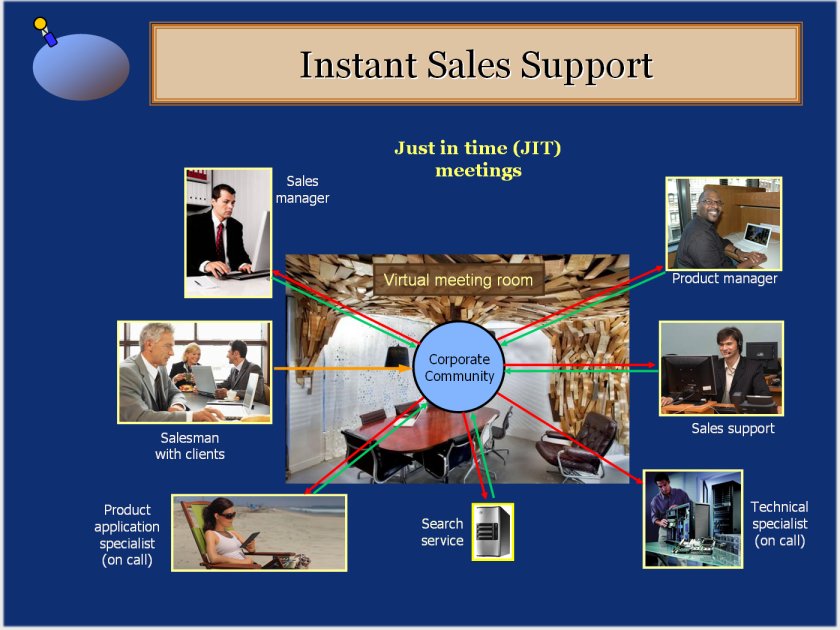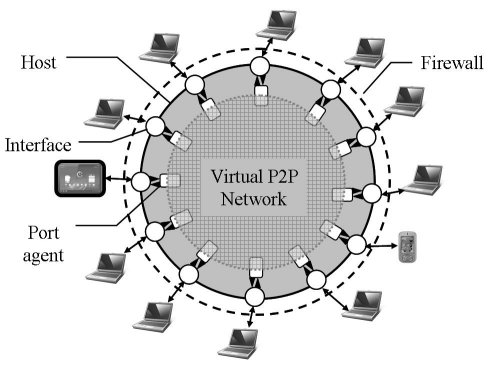What is it?
Group Spaces is a network synchronization platform
that allows the spontaneous formation of temporary,
task-oriented groups, instant meetings, on-going projects,
or multi-player games, facilitated by personal "nodes"
that watch the network for the instantiation of events
of interest and monitor traffic. Group Spaces is a
"virtual (hosted/cloud) peer-to-peer" technology that
enables rapid synchronization of nodes. This enables
instant group activity vs. just group sharing. Group
Spaces creates "just-in-time" instant groups. A group
forms automatically and vanishes when no longer used.
It provides an active, immersive Web experience. The
technology provides focused invitations to members
of a community to join the group. An instant group
may optionally persist or vanish when all members
leave. The members of an instant meeting may be limited
to members of a specific community.
Why is it needed?
Group Spaces can create just-in-time meetings. Imagine a salesman working with a potential client selling a nurse scheduling management package to a big hospital that already has an HR package in place. The client asks a technical question about the system interface. The salesman opens his laptop, logs in to the corporate Group Space and puts in a specific request for support on the topic. Those who are available (PC, tablet, smartphone) and feel they can contribute respond to the request. The meeting space forms. The salesman selects the participants. The issue is resolved while the client is there. The group is closed--and vanishes.

Social networks make it possible to be in contact
with a large number of people at one time, providing
a large pool of people with common interests. Social
networks need to rapidly assemble a group for some
immediate need without polling everyone. Currently,
subscription to a group or community may result in
a large number of messages of low interest to the
individual. What is needed is focus: the individual
only wants to see the messages that relate directly
to his or her interests. An instant
meeting can form automatically around people
with a common interest and willingness to participate.
People like to be involved
in immediate experiences. A meeting or group should
form on an as-needed basis, using the appropriate
activity space and resources. There should be no need
to pre-establish a group. A group or meeting should
vanish when no
longer needed, freeing up resources. A system should
be able to serve a large number of people with good
personalization. Such a system must self-manage.
How does it work?
A Group Spaces community is comprised of people and
resources with a common
focus. This focus may be recreational, organizational,
interest or business. An instant meeting or similar
activity forms among members of that community when
any member send out a request for participation. Group
Spaces can provide group access to an activity space
such as a Web meeting room, VOIP, games and simulations.
Activity spaces may include tools and services. Group
Spaces also provides rapid communication of brief
messages within a group including background control
of the activity space. Such message capabilities provide
a rich infrastructure for innovative applications.
The Group Spaces invention is a component of social
networking platform using real and virtual
peer-to-peer networks and a multi-agent system. It
includes a coherent peer-2-peer (p2p) network and
methods and systems for creating communities within
that network and instant groups for collaborative
activities. A peer-to-peer (p2p) network is a system
of nodes that communicate with each other with no
system intermediary. Each node acts autonomously,
distributing operations throughout the network. This
system allows any node to contact any other node in
a system, either directly or relayed through nodes.
This invention is an extension of research reviewed
in Arenas, A., Díaz-Guilera, A., Kurths, J.,
Moreno, Y., & Zhou, C. (2008), "Synchronization in complex networks" Physics Reports, 469(3), 93-153.
Group Spaces uses a synchronized
network of nodes. Synchronized networks formed
by coupled nodes have properties that are not the
simple sum of the nodes' behaviors. The system responds
like a bell: struck anyplace, it all rings together.
Even though the couplings among nodes may be quite
limited in number relative to the total number of
nodes, and even if the coupling is moderately weak,
the entire network can behave as a unified structure
in which events are transferred extremely rapidly
throughout the network. The method of node coupling
is innovative. Group Spaces employs self-synchronization
of the network that both reduces system management
requirements and optimizes for performance over that
of a centrally clocked system. Multiple separately
synchronized communities may exist at multiple levels
within a common environment, Group Spaces.

In this description, the nodes are ports. Users are
connected to ports, allowing a strong security firewall.
These ports can be realized as intelligent agents
in a multi-agent system (e.g., Tryllian, Ascape, Cougaar,
CybelePro, JAS, Madkit, MAGSY, Moduleco and Swarm).
The behavior of the ports couples them into a network.
Under the proper conditions this network can become
synchronized. A synchronized network has all ports
operating with a common cycle time with small, transient
variations. It does not imply that the ports are actually
oscillating. There is little lag in propagating events
across the network. Such networks offer multiple opportunities
to provide security. Task-specific groups can emerge
rapidly by manipulating the synchronization characteristics
of the relevant nodes. The limited coupling among
nodes reduces server loads, allows load balancing
and needs only limited data exchange among servers
in extended systems. The system can self-manage with
administrative control at a high level.
Objectives
Let me hear from you. I look forward to evaluations
of Group Spaces. I would like to consult on projects
using this technology. The technology is also available
for patenting. There is a US Provisional Application
for Patent filed. This is a pending patent. A provisional
application describes an innovation in considerable
detail, such that it can be implemented, but is not
a formal patent application. The intent is to establish
primacy of innovation such that a patent application
can be filed within a limited time frame. Obviously,
moving quickly is important.

